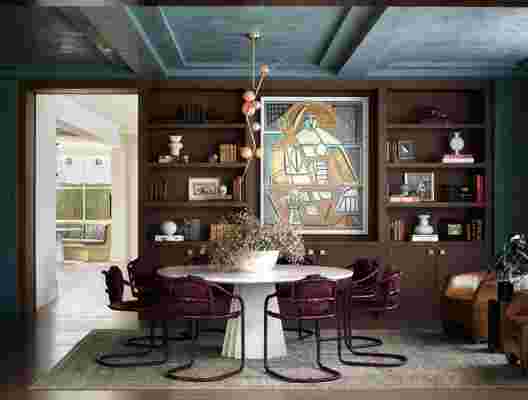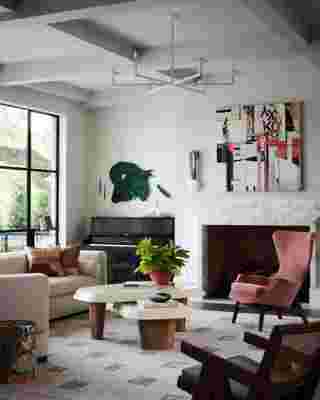When an architect and a designer are given carte blanche, it can be exhilarating yet daunting. What eras to draw inspiration from? Just how much texture and color should interior spaces have? Those are only some of the questions that frequent collaborators Ryan Street of Ryan Street Architects and Emily Seiders of Studio Seiders asked themselves after a young family hired them to reimagine their recently purchased Austin home. Built in the 1970s on the shores of Lake Austin, the 8,000-square-foot property possessed a coveted location but an outdated look.
The clients, a couple with two small children and two high-profile jobs, wanted an “inviting” abode in which they could relax and entertain. “Design in general is not one of our strengths, so it was key to work with a team that we trusted and [that we] could empower to manage every detail from start to finish,” says one of the clients, a tech executive. “We just knew that we wanted the space to feel connect[ed to] the lake and [to] the outdoors in general.”

Architect Ryan Street and interior designer Emily Seiders teamed up to build and design this layered, highly detailed home on Lake Austin. In the dining area, which is connected to a bar and a parlor, a bleached white-oak dining table (designed by Seiders) was paired with leather-wrapped burgundy chairs from Ochre . The delicate chandelier, by Lindsey Adelman , has rosy glass globes that match the colors of the nearby parlor.
Since the house didn’t have a practical layout or a distinctive architectural style, it made sense to take it down to the studs. The residence did, however, have attractive tan bricks that covered its exterior walls. Everyone agreed to reuse them on the renovated façade. Now, those bricks are juxtaposed with massive steel-framed windows, limestone sills, and a pitched copper roof to make for a contemporary style reminiscent of European chalets and New York City townhouses. “The overarching idea was to create something timeless that fit in with the neighborhood and the site,” says Street, who adds that many of the area’s properties date back to the early 1900s. “There’s a reference to classical architecture, but [one that is] reduced to its essential forms.”
For the interiors, Seiders took cues from the clients’ personalities and stories about their travels (“they loved Soho Farmhouse in Oxfordshire and enjoy spending time in Manhattan”) in order to come up with a design that’s easy yet refined with just a touch of whimsy. “We were not chasing trends, and that’s something hard to do in this digital age,” says Seiders. “I wanted to create a home that’s livable but very special, with a whole lot of attention to detail.”


Buy now for unlimited access and all of the benefits that only members get to experience.
In the main living area, which has a row of connected rooms, Seiders played with the concepts of masculinity and femininity, going from a bright and fresh palette in the parlor to a dark and moody look for the adjacent bar, and then tying it all together in the dining area. That space has a delicate brass chandelier with rose-hued globes that mimic the colors of the parlor, while the dark burgundy dining chairs complement the look of the wine bottles on display at the bar. Rich architectural details abound throughout the five-bedroom house, including ribbed wooden paneling, uniquely patterned parquet floors, and plaster walls, which reflect natural light over coffered ceilings.
And then there are the views of Lake Austin, complete with a resplendent live oak tree on the water’s edge that makes the garden look like a postcard. “For us it was sort of a dream project,” says Street. “We presented our clients with things that we love and they happened to love them too.”
